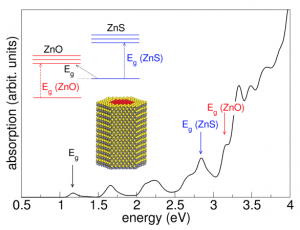his activity deals with the development of original methods and numerical codes for the simulation of physical properties and spectroscopies of materials and nanostructures. The proposed solutions operate as post-processing steps on the basis of planewave DFT simulations.
1. REAL SPACE APPROACHES FOR ELECTRONIC STRUCTURE ANALYSIS
i. AB INITIO TIGHT-BINDING HAMILTONIANS
 This project is dedicated to development of python codes for the advanced analysis of the electronic and transport (Boltzmann like) properties in extended bulk systems and interfaces, as well as for the simulation of optical spectroscopies. This approach is based on an original method for the evaluation of ab initio tight-binding Hamiltonians, derived from fully self-consistent quantum-mechanical calculations.
This project is dedicated to development of python codes for the advanced analysis of the electronic and transport (Boltzmann like) properties in extended bulk systems and interfaces, as well as for the simulation of optical spectroscopies. This approach is based on an original method for the evaluation of ab initio tight-binding Hamiltonians, derived from fully self-consistent quantum-mechanical calculations.
Collaborations: M. Buongiorno Nardelli (Univ. North Texas, SA), M. Fornari (Central Michigan Univ. USA) .
Main references
[1] B. I. Adetunji, A. Supka, M. Fornari, and A. Calzolari, "High-throughput investigation of the electron transport properties in Si1-xGex alloys", IEEE Access 9, 141121 (2021).
[2] P. D’Amico, L. Agapito, A. Catellani, A. Ruini, S. Curtarolo, M. Fornari, M. Bongiorno Nardelli, and A. Calzolari, "Accurate ab initio tight-binding Hamiltonians: effective tools for electronic transport and optical spectroscopy from first principles", Phys. Rev. B 94, 165166 (2016).
[3] A. Calzolari and M. Buongiorno Nardelli, "Dielectric properties and Raman spectra of ZnO from a first principles finite-differences/finite-fields approach", Sci. Rep. 3, 2999 (2013).
[4] L. A. Agapito, A. Ferretti, A. Calzolari, S. Curtarolo, and M. Buongiorno Nardelli, "Effective and accurate representation of extended Bloch states on finite Hilbert spaces", Phys. Rev. B 88, 165127 (2013).
ii. TRANSPORT IN NANOSTRUCTURES (WanT - project)
 TThe WanT Project is devoted to the evaluation of the electronic and heat transport in nanostructures, such as nanotubes, atomic chains and molecular junctions. WanT code (www.wannier-transport.org) implements a real-space Green's function solution of the Landauer equation for both electron and phonon carriers. Originally implemented for coherent transport in nanostructures, WanT is now extended to include el-el correlation effects, beyond the mean field approximation.
TThe WanT Project is devoted to the evaluation of the electronic and heat transport in nanostructures, such as nanotubes, atomic chains and molecular junctions. WanT code (www.wannier-transport.org) implements a real-space Green's function solution of the Landauer equation for both electron and phonon carriers. Originally implemented for coherent transport in nanostructures, WanT is now extended to include el-el correlation effects, beyond the mean field approximation.
Collaborations: M. Buongiorno Nardelli (Univ.of North Texas, TX USA), T. Jayasekera (Southern Illinois Univ. IL USA).
Main references
[1] L. Cigarini, A. Ruini, A. Catellani, and A. Calzolari, "Thermoelectric figure of merit of polymeric systems for low-power generators", J. Phys. D: Appl. Phys. 50, 395502 (2017).
[2] A. Calzolari, T. Jayasekera, K.W. Kim, and M. Buongiorno Nardelli, "Ab initio thermal transport properties of nanostructures from density functional perturbation theory", J. Phys. Cond. Matter. 24, 492204 (2012).
[3] R. Mao, B. D. Kong, K. W. Kim, T. Jayasekera, A. Calzolari, and M. Buongiorno Nardelli, "Phonon Engineering in Nanostructures: Controlling Interfacial Thermal Resistance in Graphene/Dielectric Systems", Appl. Phys. Lett. 101, 113111 (2012).
[4] A. Calzolari, N. Marzari, I. Souza and M. Buongiorno Nardelli, "Ab-initio transport properties of nanostructures from maximally-localized Wannier functions", Phys. Rev. B 69, 035108 (2004).
2. HIGH-THROUGHPUT APPROACHES FOR MATERIALS GENOMICS (AFLOWpy - project)
 Python workflows and finite-field/finite-different solutions for the high-throughput investigation of electronic and vibrational (e.g. phonon dispersion, IR, Raman) properties of materials and materials discovery. Systems of interest include: transparent conductors and topological insulators. This work contributed to development of the AFLOWpy code within the AFLOWLIB Consortium for materials genomics (www.aflowlib.org).
Python workflows and finite-field/finite-different solutions for the high-throughput investigation of electronic and vibrational (e.g. phonon dispersion, IR, Raman) properties of materials and materials discovery. Systems of interest include: transparent conductors and topological insulators. This work contributed to development of the AFLOWpy code within the AFLOWLIB Consortium for materials genomics (www.aflowlib.org).
Collaborations: M. Buongiorno Nardelli (Univ.of North Texas, TX USA), M. Fornari (Central Michigan Univ., Mt. Pleasant, MI, USA); S. Curtarolo (Duke Univ. Duraham, NC USA).
Main references
[1] M. Esters, C. Oses, S. Divilov, H. Eckert, R. Friedrich, D. Hicks, M. J. Mehl, F. Rose, A. Smolyanyuk, A. Calzolari, X. Campilongo, C. Toher, and S. Curtarolo, "aflow. org: A Web Ecosystem of Databases, Software and Tools", Compt. Mater. Sci. (2022), in press.
[2] C. Toher et al., "The AFLOW Fleet for Materials Discovery", in Handbook of Materials Modeling: Methods: Theory and Modeling, pp. 1-28, Springer International Publishing (2018).
[3] A. R. Supka, T. E. Lyons, L. Liyanage, P. D’Amico, R. A. R. Al Orabi, S. Mahatara, P. Gopal, C. Toher, D. Ceresoli, A. Calzolari, S. Curtarolo, Marco Buongiorno Nardelli, and Marco Fornari, "AFLOWπ: A minimalist approach to high-throughput ab initio calculations including the generation of tight-binding hamiltonians", Comput. Mater. Sci. 136, 76 (2017).
[back]
